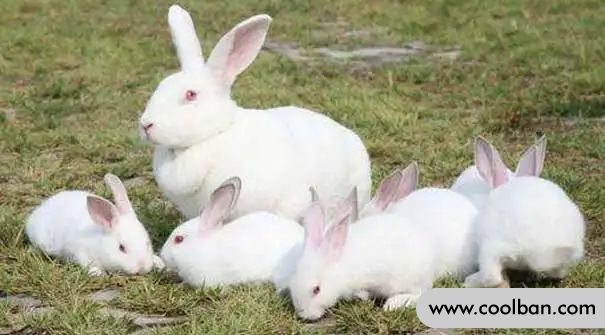How to raise Japanese big-eared rabbits?
The Japanese big-eared rabbit is actually a kind of white rabbit that grows in Japan, so it is also called the Japanese white rabbit. It is said that it is a hybrid of Chinese white rabbit and Japanese white rabbit, mainly for economic production. Early maturing, fast growth, resistance to roughage; good motherhood, strong fecundity, often used as a "nanny rabbit", with good meat quality and excellent cortex.
Morphological characteristics of Japanese big-eared rabbits
The appearance of Japanese big-eared rabbits looks very large, especially a pair of large ears, which are scattered on the top of the head in a "V" shape, wide, thick and long. The color is red and the coat is of average quality.
Japanese big-eared rabbits have pure white coat, red eyes, lobes under the throat of female rabbits, especially large ears, which are shaped like willow leaves and have a rectangular body. Weighing 4.8 kg, the ears are less than 18 cm long, and the coat is dense and about 2.5 cm long.

Japanese big-eared rabbit breeding knowledge
1. The main points of spring breeding of Japanese big-eared rabbits
Spring is the season of frequent rabbit diseases, so pay attention to environmental hygiene. The cages should be clean and dry, and the cages should be cleaned daily to remove feces and rinse the feeding troughs. Make sure there is no odor in the house and no accumulation of feces. Food utensils, cage bottoms, and production boxes should be cleaned and disinfected frequently. The rabbit house in indoor cages should be well ventilated, and the ground should be sprinkled with plant ash and lime to be disinfected and moisture-proof.
Due to the high rainfall and humidity in spring, it is extremely beneficial to the reproduction of bacteria. Therefore, keep the cage clean and hygienic, keep the cage clean, dry, and frequently wash, wash, rinse and disinfect. When the ground humidity is high, plant ash or quicklime can be sprinkled for disinfection and sterilization.
2. The main points of raising Japanese big-eared rabbits in summer
summer feeding management In summer, the temperature is high, the rainfall is high, and the humidity is high. Japanese rabbits are often affected by heat and reduce their food intake due to hypoplasia of sweat glands. This season poses the greatest threat to young and young rabbits. In this season, the first is to do a good job of preventing heatstroke and cooling; the second is to cultivate carefully, pay attention to feeding more feed, and drink enough water; the third is to do a good job of cleaning and sanitation, mix the summer concentrate and cold water for feeding, and the feed and remaining feed should be stored in a cool and dry place. ventilation.
In summer, the rabbit house should be cool and ventilated, and the rabbit cage should not be directly exposed to sunlight. When the temperature in the cage exceeds 30 ℃, water can be poured on the ground to cool down; the open-air rabbit farm should build a pergola in time, plant melons, grape vines and other climbing plants as soon as possible, and prevent moisture.

3. The main points of raising Japanese big-eared rabbits in autumn
Autumn breeding management In autumn, the weather is high, the weather is dry, and the feed is sufficient. This is a good season for raising Japanese rabbits. In this season, pay close attention to fattening in autumn. However, adult rabbits have entered the moulting period. During the moulting period, the physique of the rabbit is weak and the appetite is lost. Green fodder and high protein feed should be properly fed. In autumn, the temperature difference between morning and evening is large, which is easy to cause diseases such as colds, pneumonia, and enteritis in young rabbits. Therefore, pay attention to changes in temperature. Herds of grazing rabbits should be brought back to the house in the evening. It is not advisable to exercise outdoors when it is raining or cool.
In autumn, the temperature difference between morning and evening and noon is large, and young rabbits are prone to colds, enteritis, pneumonia and other diseases. Therefore, it must be carefully managed, the group of rabbits are driven back indoors every night, and they are not allowed to play in the open air, in case of strong wind or heavy rain.
4. The main points of winter breeding of Japanese big-eared rabbits
Winter feeding and management, most of the north has a colder climate, more wind and snow, and winter cold protection is the key to raising rabbits in winter. To this end, the first is to strengthen cold protection measures; the second is to strengthen feeding; the third is to strengthen exercise. Domestic rabbits should exercise at all times. The caged rabbits should choose sunny days and less windy weather every week, and place them on the sports field with full sun and leeward several times for two hours each time. For rabbits raised in a cellar, if the cellar is not well lit, choose a good day and exercise in the sun, no less than twice a week.
The temperature of the rabbit house in winter does not need to be very warm except for the newly born rabbits, but the temperature should be kept relatively stable, and it should not be hot and cold by all means. Indoor caged rabbits should close doors and windows to prevent burglars from invading. When raising rabbits outdoors, the cage door should be hung with straw curtains to prevent cold wind from invading, and the bottom of the cage can be covered with grass or other materials to keep warm.
